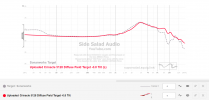acerto
Interesting! I compared the Sonarworks target vs the 5128 Diffuse Field target with -0.8dB Tilt and the treble differs a lot. A lot of criticism I've seen about the Sonarworks target is that the accuracy of their treble correction is unreliable, simply because they don't make anything public about their measurements, other than "the default correction is an average based on several measurements of the same headphone model". 5128 measurements on the other hand have very solid explanations on to why they're reliable and even the best ones at the moment. Trusting the Sonarworks target is kind of a taking a shot in the dark. I'd much rather trust the Harman target, which has very well documented research explaining it, or even the tilted Diffuse Field target if you have a headphone that happens to be measured on a 5128 rig. Just my 2 cents


